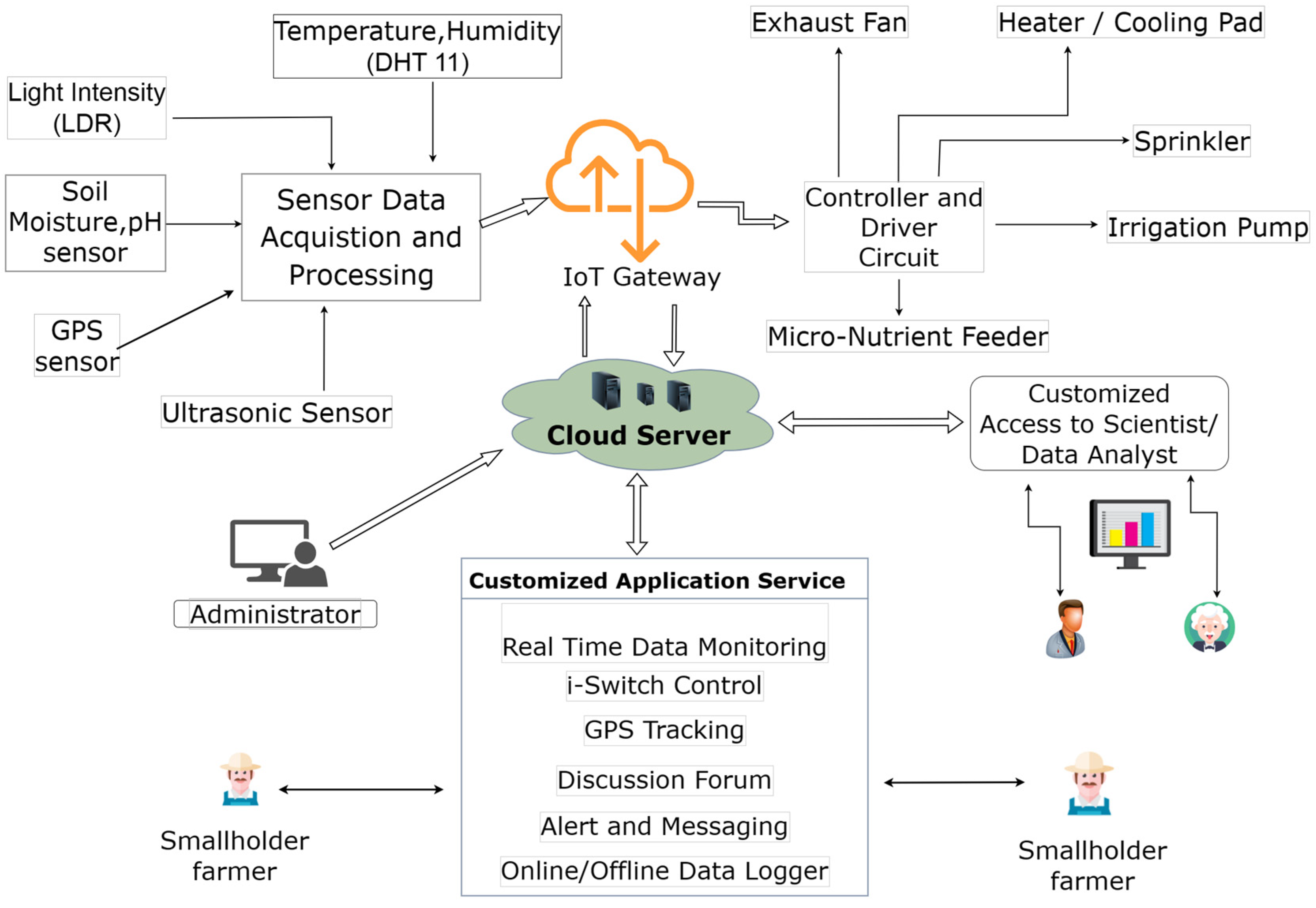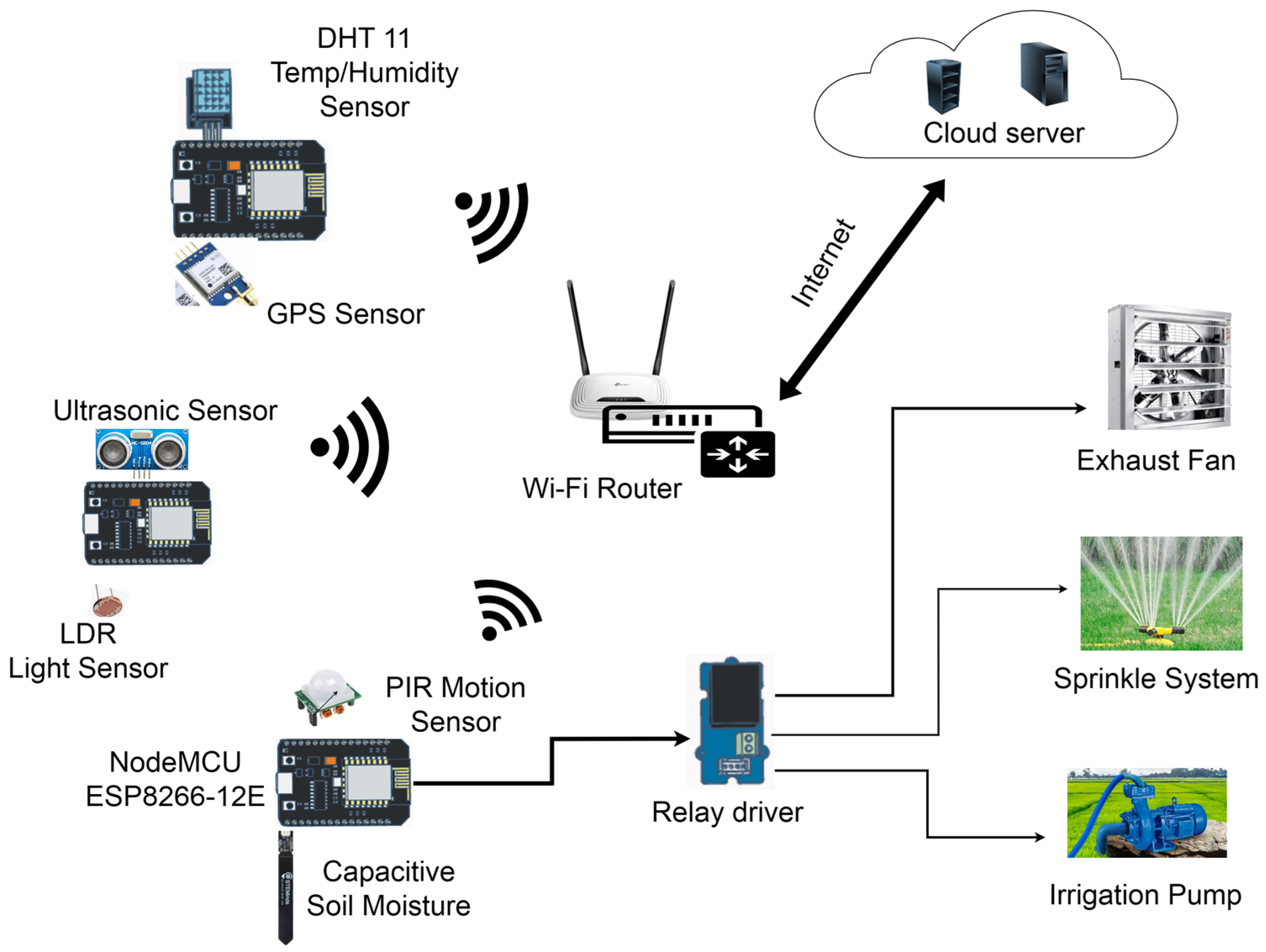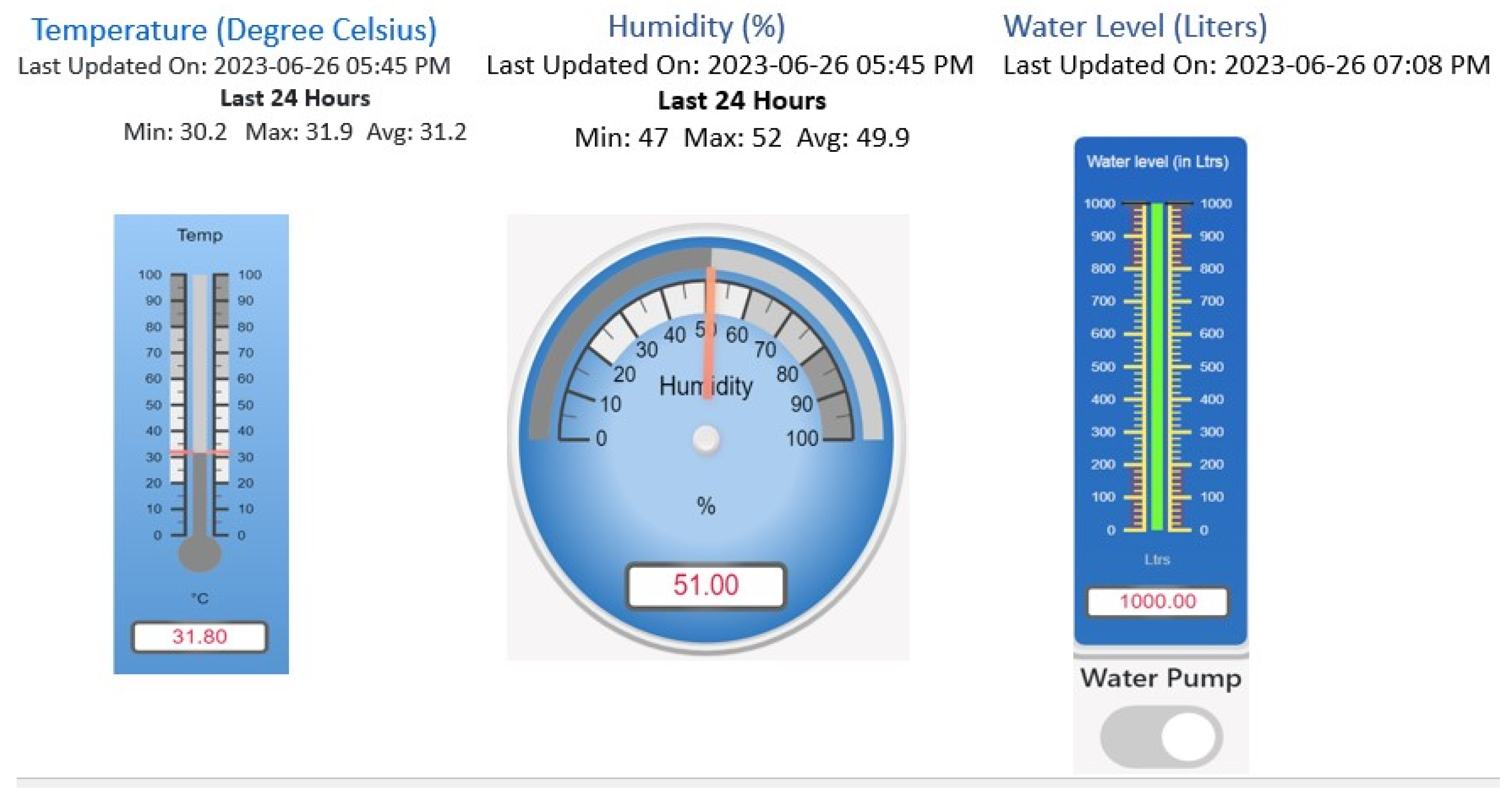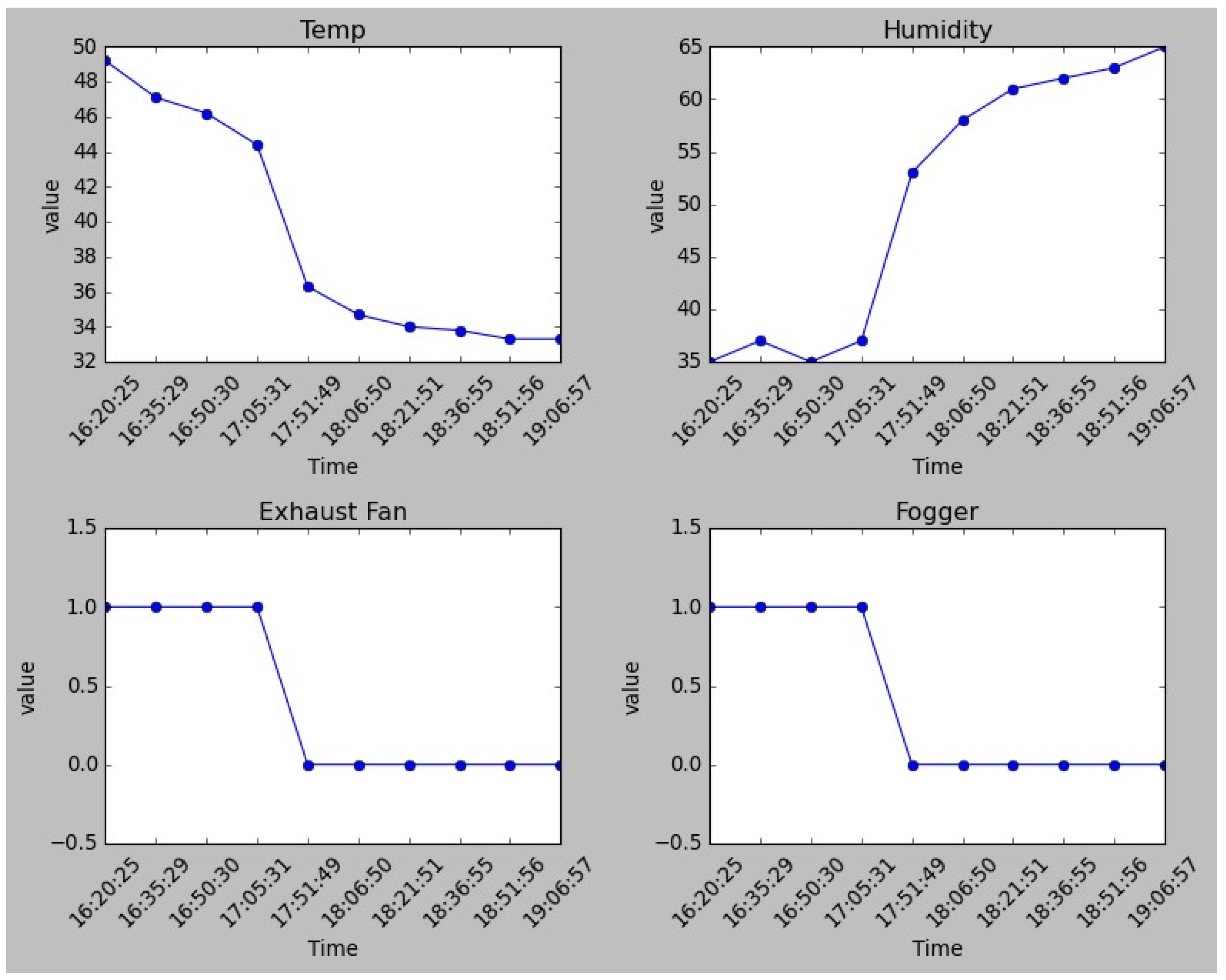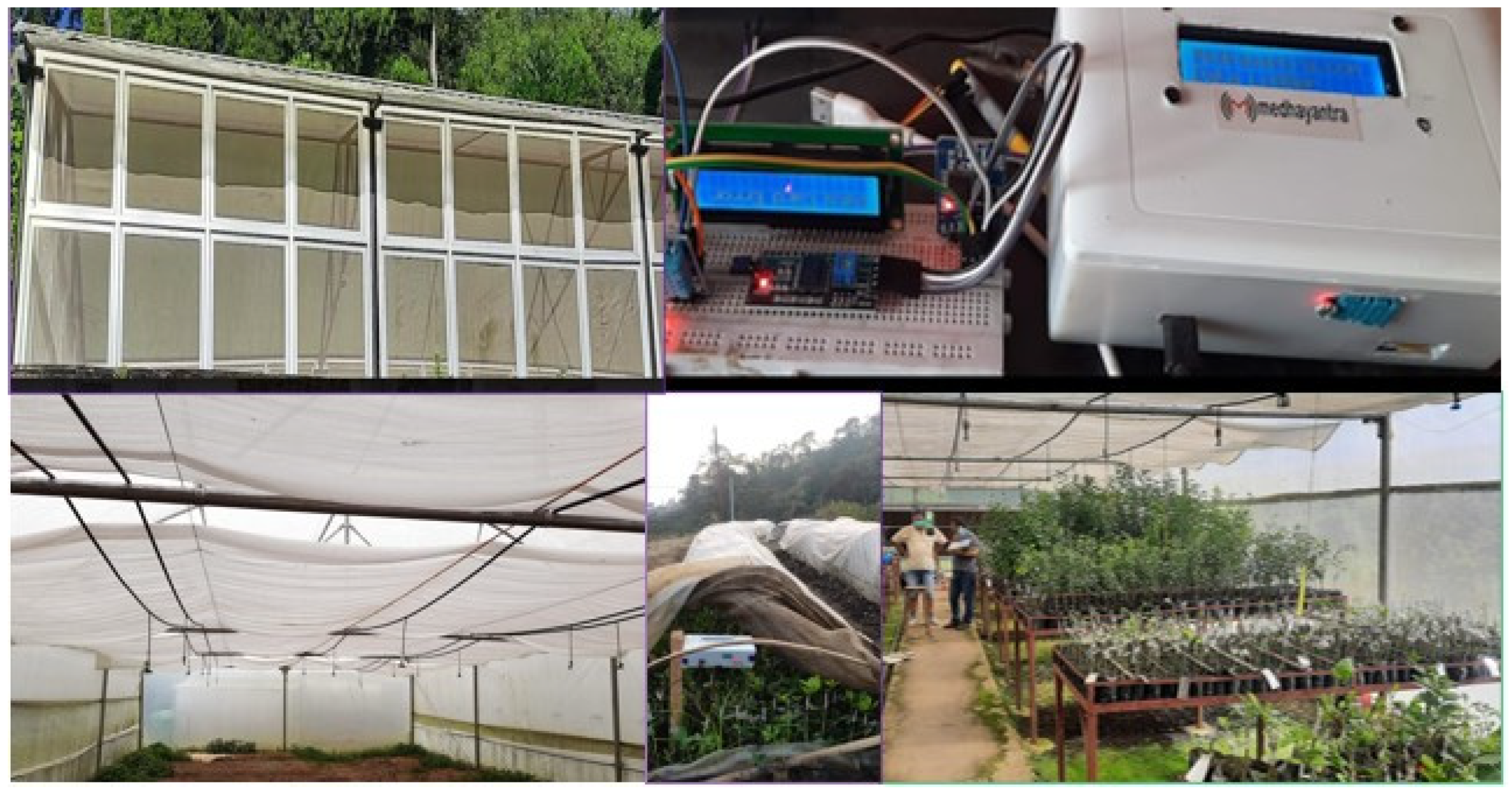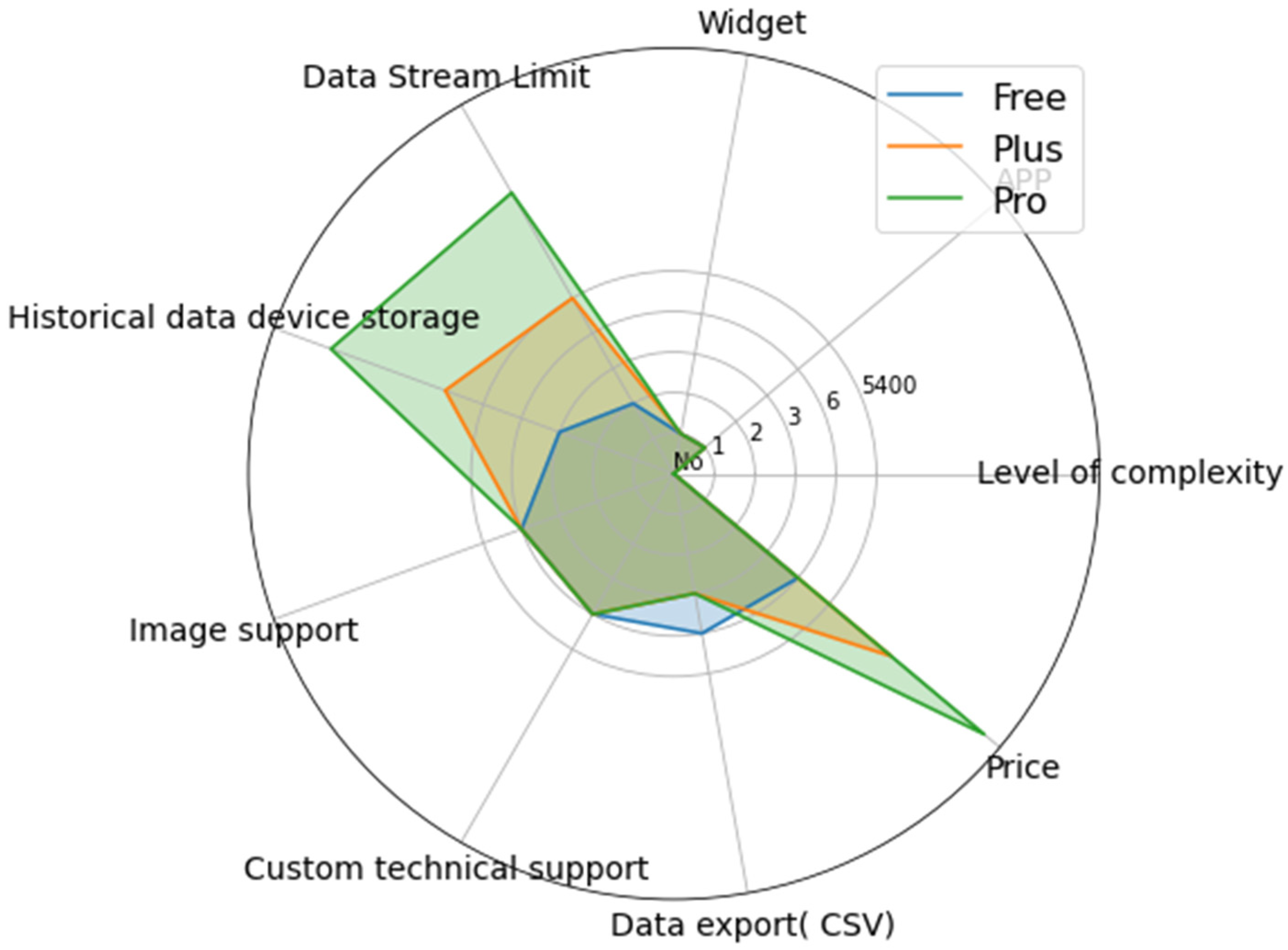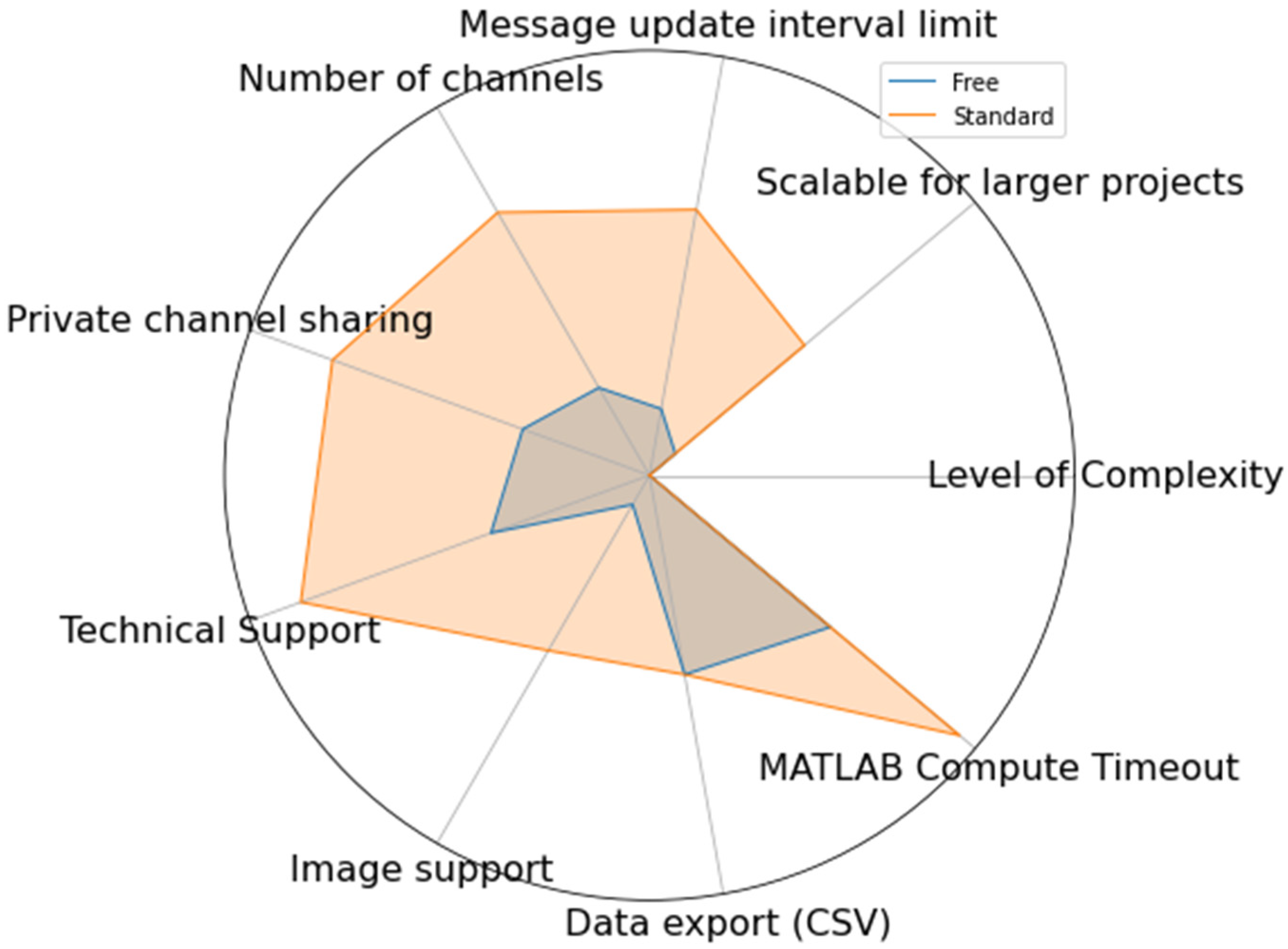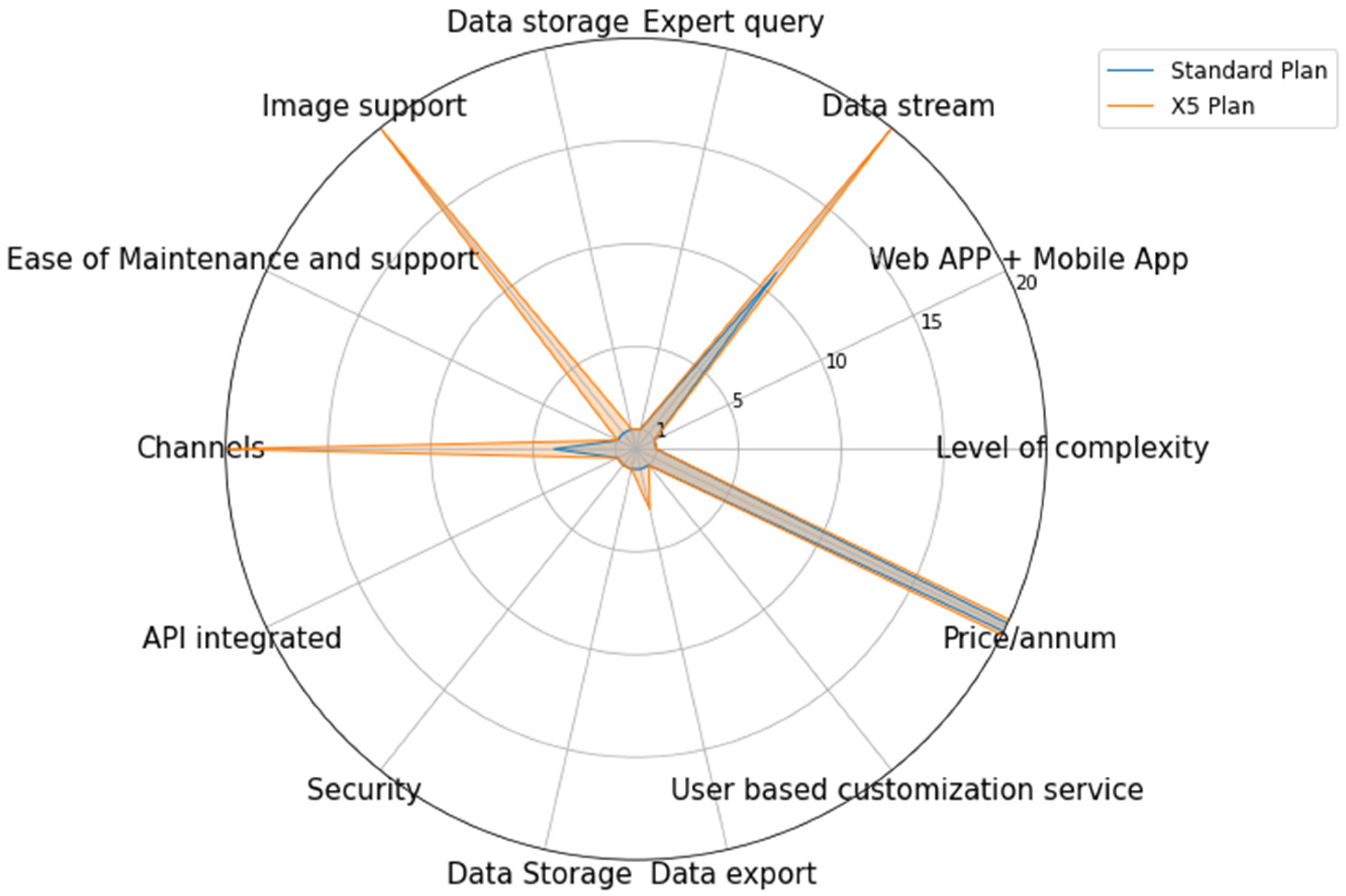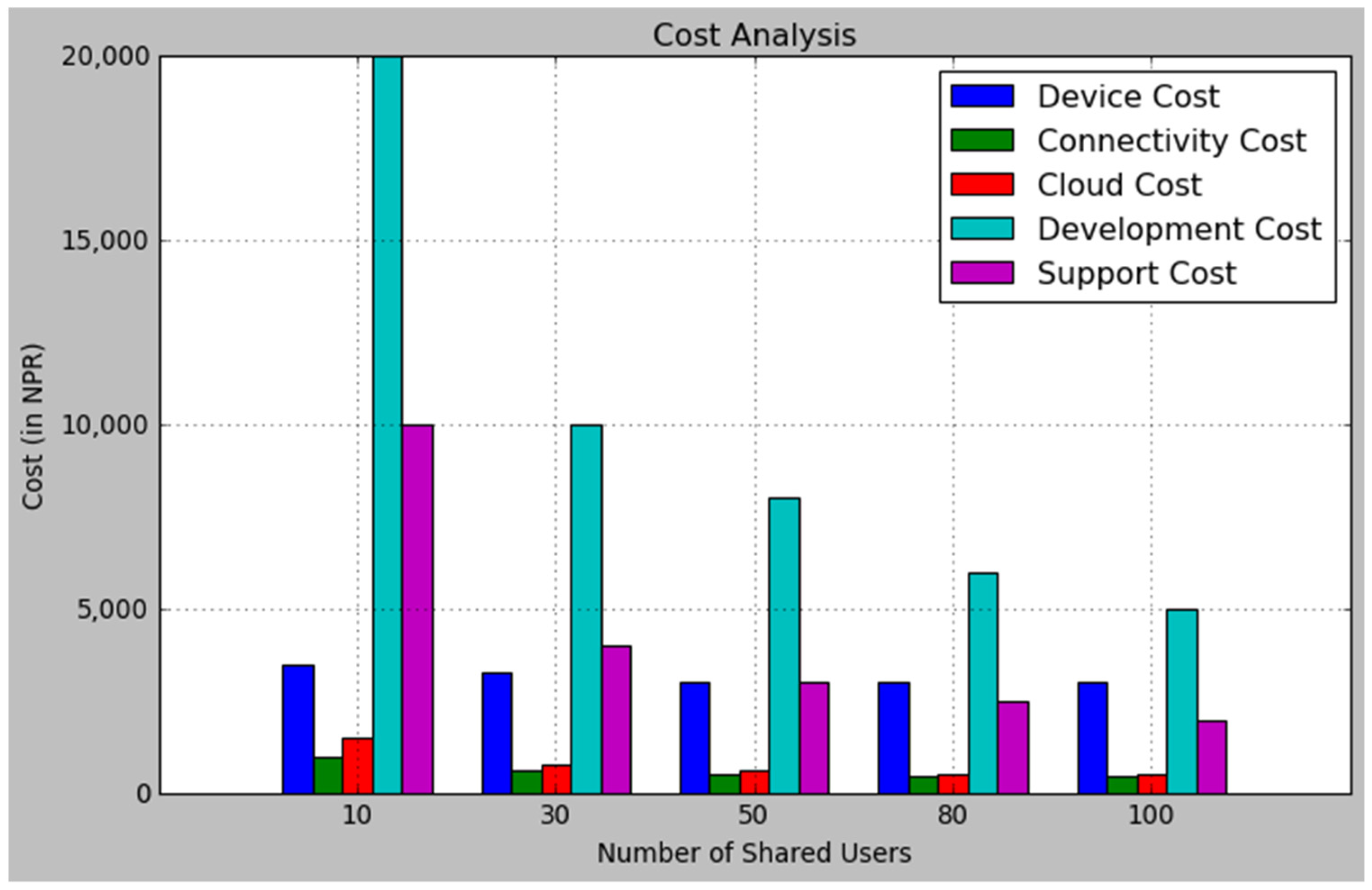1. Introduction
The Internet of Things (IoT) is an emerging technology which has been significantly increasing recently in many application domains such as smart cities, industrial manufacturing, home automation, precision agriculture, the health industry, wearables, etc. The IoT-based system includes a network of different sensors and actuators that can be integrated into the cloud service using the internet. Cloud-based applications and services can be accessed using network-enabled devices like smartphones, laptops, and other digital devices anytime, anywhere. IoT-based systems in agriculture can assist farmers in streamlining their labor and managing their resources efficiently. The information about the weather, soil properties, fertilizer, pests, and other variables can be obtained in real time using an IoT-based system [
1,
2,
3]. Smallholder farmers in many lower-middle-income countries play a crucial role in global food production [
4]. However, limited technological resources and access to information are the most challenging issues they often face. With the rising number of industries utilizing IoT, the agriculture sector is also one potential industry that can benefit significantly from IoT. On the other hand, designing a reliable, affordable IoT platform suitable for agricultural farms for smallholder farmers of middle- and lower-income countries with limited resources is always challenging [
4,
5].
The essential components of IoT-based systems in agriculture include sensor networks, edge computing, and cloud computing. The sensor network collects data on weather conditions, soil moisture, and crop growth and controls irrigation systems. Edge computing processes and analyses sensor data close to the field. Cloud computing can store and analyze data from sensor networks and other IoT-based systems.
1.1. Challenges and Opportunities of IoT in Agriculture for Smallholder Farmers: In Context of Nepal
Most of the farmers in Nepal are smallholder farmers with modest land holdings [
6]. Smallholder farmers are also most of the agricultural labor force, accounting for more than 80% of all farm production. Despite being an agrarian country, the majority of the agricultural products are imported. The traditional way of farming solely relying on manual labor has not been productive these days. The rising cost of production, on the other hand, the shortage of manpower severely affects overall agricultural production. This has not only demotivated them to preserve their farming tradition but also significantly impacted their socio-economic status. The departure of the youth for foreign employment, the concept of a lower mindset for agriculture business, and the lack of access to technology and information have led to un-cultivating acres of land.
In this context, the IoT system could revolutionize how smallholder farmers manage their farms. There are, however, challenges to its implementation. One of the main challenges is the cost of deploying and maintaining IoT-based systems. Another challenge is the limited technical capacity of smallholder farmers, who may need more skills or resources to use IoT-based methods [
7] effectively. Several factors can make IoT in agriculture for smallholder farmers in Nepal differ from other regions. Nepal’s geographical location, topography, and climate can make farming in Nepal challenging. Many smallholder farmers in Nepal may need more access to capital, credit, and technology, which can affect the adoption and use of IoT. The lack of infrastructure, such as reliable electricity and internet connectivity, can limit the potential benefits of IoT in agriculture for smallholder farmers in Nepal. The cost of implementation and deployment of IoT systems is another potential challenge. Technical expertise and know-how of IoT devices and their operation is also a significant challenge. The agricultural practices and crops grown in Nepal may differ from other regions. Despite these challenges, the potential benefits of IoT for smallholder farmers in Nepal are significant, including increased efficiency, improved yield, reduced costs, and access to markets. For many years, the Nepal government has been focusing on improving agricultural production and commercialization by introducing some key plans and strategies. The government’s recent initiative is the Prime Minister Agriculture Modernization Project, Agricultural Development Strategy (2015–2035), which aims to implement modern technology to enhance agricultural productivity and commercialization [
8]. With these initiatives and motivation, smallholder farmers will gradually start using the technology, familiarizing themselves with its operation and benefits. However, close coordination with the Government, local bodies, and communities is needed to overcome the challenges of understanding their specific needs and to ensure that the system is relevant to their needs.
1.2. Real Use Case Scenario from Smallholder’s Perspective
The proposed IoT platform for smallholder farmers presents compelling real-world applications across various agricultural scenarios. These applications include:
Mushroom Farming: Mushroom cultivation is a popular endeavor among smallholder farmers in Nepal due to its quick turnaround and profitability. The IoT platform can play a pivotal role in mushroom farming by enabling precise control of environmental factors such as darkness, temperature, and humidity, which are critical for successful mushroom growth.
Polyhouse Tunnel Agriculture: The adoption of polyhouse tunnels for tomato cultivation is on the rise. Within these controlled environments, the IoT platform offers effective management of climatic conditions and irrigation, ultimately leading to increased productivity and higher profits for farmers.
Nursery Operations (Fruit and Flower Plants): Grafting fruit and flower plants in a nursery demands meticulous internal microclimate control. The IoT platform provides an ideal solution for managing these conditions, ensuring optimal growth and development of plants.
Poultry Farming: A significant number of smallholder farmers in Nepal operate small-scale poultry farms. The IoT platform facilitates real-time remote monitoring of crucial parameters within the poultry farm, including temperature, humidity, and air quality. It can also be employed to automate feed and water systems. Additionally, real-time heating, cooling, and lighting systems can be automated to optimize energy consumption.
Farm Security and Access Control: Ensuring security and controlled access to a farmer’s premises is of paramount importance. The IoT platform can be harnessed for this purpose, integrating sensors and actuators such as motion sensors and alarms. These elements provide early intrusion detection and facilitate prompt responses to safeguard the farm.
Incorporating the IoT platform into these agricultural contexts not only enhances the precision and efficiency of farming practices, but also empowers smallholder farmers in Nepal to achieve better yields, improved profitability, and enhanced security measures, ultimately contributing to the sustainable growth of their agricultural endeavors. In essence, this research not only identifies the unique demands and challenges faced by smallholder farmers in resource-constrained developing countries, but also offers a tangible solution in the form of a deployable, cost-efficient, and reliable IoT platform. By rigorously evaluating its features and performance, this study contributes to the advancement of agricultural technology, particularly in contexts where smallholder farmers play a pivotal role in sustaining local and national food production.
The remainder of the paper is organized as follows.
Section 2 discusses the related work. Material and methods are discussed in
Section 3.
Section 4 discusses the results, and
Section 5 concludes the research with possible future directions.
2. Related Work
Doshi et al. developed a smart farming prototype using a third-party cloud application that connects various agriculture sensors and displays sensor data on the farmer’s smartphone [
9]. Ayaz et al., in their article, highlighted the potential use and challenges of wireless sensors and IoT in agriculture. Authors have also analyzed the IoT devices and communication techniques associated with agriculture applications [
10]. Nigussie et al. propose an “IoT-based irrigation management for smallholder farmers in rural sub-Saharan Africa” and found that an IoT-based irrigation management system can significantly improve the efficiency and effectiveness of irrigation for smallholder farmers in rural sub-Saharan Africa. The study conducted in Ethiopia showed that the system was able to reduce water use by 60% while maintaining or increasing crop yields. The design provided farmers with real-time information on soil moisture levels and weather conditions, allowing them to make informed decisions about when and how much to irrigate [
11]. Dahane et al. present low-cost smart farming for enhancing the irrigation efficiency of smallholder farmers. The study conducted in Algeria showed that the system using low-cost sensors and a mobile application provided real-time data and feedback to farmers, reducing water consumption by up to 50% while maintaining or increasing crop yields. The authors suggest that IoT-based smart farming systems can significantly enhance irrigation efficiency but require careful attention to affordability, accessibility, local context, and collaboration between stakeholders [
12]. Bayih et al. describe a case study in Ethiopia where an IoT and wireless sensor network (WSN)-based system was implemented for smallholder farmers to monitor and control their irrigation and fertilization practices. The system used low-cost sensors and a web-based platform to provide real-time data and feedback to farmers. The study found that the system could significantly improve crop yields, reduce water usage, and increase fertilizer efficiency while reducing labor costs and minimizing environmental impact [
13].
Maraveas et al. review studies on IoT-based greenhouse monitoring and control systems which use sensors and actuators to collect and adjust environmental factors. These systems can improve crop growth and quality, energy efficiency, and resource management. The authors suggest that these systems can enhance the sustainability and profitability of greenhouse agriculture, but implementation requires careful attention to issues such as affordability, reliability, scalability, and collaboration between stakeholders [
14]. Lufyagila et al. discuss using an IoT-powered system to monitor environmental conditions in a poultry house in Tanzania. The study deployed a low-cost system with sensors to monitor temperature, humidity, and air quality and a cloud-based data storage and analysis platform. The results showed that the system effectively improved animal health and productivity, was user friendly and accessible, and highlighted the importance of sustainable technologies in developing countries agricultural sectors [
15]. Quayson et al. introduce a framework for technology for good social foundations in sustainable supply chains, emphasizing the importance of a supportive environment for smallholder farmers, including access to technology, training, and market incentives. The research highlights the potential for technology-based interventions to improve social and environmental outcomes and calls for future research to ensure inclusivity for smallholder farmers in developing countries [
16]. Cheng et al. present a study on the development and implementation of an intelligent agriculture system that utilizes IoT technology in Taiwan. The system includes environmental monitoring sensors and a cloud-based data analysis platform. The study results showed that the system improved crop yields and resource management while being user friendly and accessible. The researchers suggest that the system has the potential to improve sustainability and profitability in agriculture by reducing resource use and increasing productivity. Further system development could include automated irrigation and fertilization [
17].
Oliveira-Jr et al. discuss a case study on developing and deploying an IoT-based sensing platform for e-Agriculture in Mozambique. The platform included environmental monitoring sensors and a cloud-based data analysis platform. The study showed that the platform was effective in improving crop yields and resource management and being user friendly and accessible. The researchers suggest that the platform could be further developed to include weather forecasting and crop disease management, which could reduce crop losses. The study highlights the potential of IoT technology for e-Agriculture in Africa and provides insights for future research and development in other regions and for other crops [
18]. Sekaran et al. developed a smart agricultural management system using IoT. This method gathers agriculture data from sensors from the fields. It creates results for ranchers, is essential for observing harvest development, and diminishes their time and energy. The information gathered from the field is stored in the cloud and field control is achieved by using IoT gadgets. The idea introduced in the paper could expand the efficiency of the harvests by decreasing the wastage of assets used in agribusiness fields [
19]. Agricultural IoT solutions can help the sector improve operational efficiency, save costs, minimize waste, and enhance product quality.
Haque et al. developed secure IoT devices for the smart agriculture system. Smart agriculture based on the IoT is a system that uses sensors to monitor irrigation activities and automate crop production in the agricultural field. Farmers may monitor the state of their land from any location [
20]. Bera et al. presented an intelligent precession Agriculture, where drones can be used to collect the sensor data and send to a ground server station. The data are secured using block chain-based authentication [
21].
Jiang et al. described the deep learning approaches for apple fruit detection in agriculture. Deep learning, which demonstrates its ability in fruit handling and grouping, is utilized to arrange apples. The profound neural organization with various convolution layers and individual neurons is analyzed and assessed [
22]. Bu et al. introduced a smart IoT agriculture system with deep learning reinforcement integrated in the cloud server for smart decisions, like how much water is required for the better growth of the crop [
23]. Parvathi et al. proposed an intelligent agriculture management system to improve agricultural benefits and crop production. The goal is to use IoT and automate the task. It is intended to perform weeding, water system, detecting mugginess, endeavoring to alarm birds and animals, keeping up with reconnaissance, and so forth, to control the geolocation of gadgets from a distance [
24]. Katanga et al. proposed an IoT-based, cost-effective hardware solution using voice-activated technology, centered around the ESP8266 NodeMCU micro-controller. It enables home automation via voice commands through Google Assistant and IFTTT integration and offers agricultural monitoring with soil moisture, temperature, and humidity analysis. The system efficiently manages water flow based on soil conditions and utilizes Wi-Fi for data transfer to cloud storage (Thingspeak) and the Blynk IoT platform [
25,
26].
Most of the work mentioned above has been concentrated on applications that either use more complicated systems or depend on third-party applications unsuitable for smallholder farmers. Smallholder farmers in low- and middle-income countries face multiple challenges in adopting the existing IoT architecture, including high costs, inadequate infrastructure, technical complexity, limited customization, and difficulties in maintenance and support. Consequently, a more affordable, user friendly, and customized IoT solution is required to cater to their unique needs and boost their productivity and livelihoods.
3. Materials and Methods
The methodology for implementing IoT architecture in agriculture for smallholder farmers follows a systematic approach that encompasses the following steps:
Comprehensive literature review: A thorough review of current IoT applications in agriculture is conducted, including potential applications for smallholder farmers and challenges and opportunities associated with implementing IoT in smallholder agriculture.
Design of the IoT architecture: The IoT architecture is designed specifically for smallholder farmers, considering their limited resources and technical capacity. Localization, customization, reliability, affordability, and scalability are considered during the architecture design.
Data collection, analysis, and field testing: Field IoT sensor devices are used to collect data, which are analyzed to assess the effectiveness of the proposed IoT architecture in addressing research objectives and questions. The proposed IoT architecture is deployed and tested in research stations and with smallholder farmers to ensure its effectiveness, reliability, and ease of use.
Evaluation of the architecture: The proposed IoT architecture is evaluated in terms of reliability, cost, and usability for smallholder farmers and compared to existing solutions.
3.1. Key Requirements
The following key requirements of the smallholder farmers are identified during the design of IoT System architecture. The key requirements are obtained by directly conversing with farmers, agriculturists, researchers, literature review, interviews, and articles.
Low cost and availability of the hardware: The IoT devices and sensors used in the platform should be low cost and readily available in the local market to be affordable for smallholder farmers.
Reliable connectivity: The platform should have a reliable and robust connectivity infrastructure, such as wireless networks and cellular networks, to ensure that data can be transmitted and received in real time.
Data management: The platform should be able to collect, store, and analyze data from IoT devices and make the data available to farmers in an easy-to-use format.
Scalability: The platform should be scalable and adaptable to the changing needs of smallholder farmers and their communities.
User-friendly interface: The platform should have a user-friendly interface that is easy for farmers to understand and use without requiring extensive technical knowledge.
Security: The platform should use robust security measures to protect the data and devices in the system, as well as the privacy of the farmers.
Localization: The platform should be localized in the sense it must use hardware and software components that are easily available, and consider the specific needs and conditions of smallholder farmers for the target region.
Community engagement: The platform should be designed to empower smallholder farmers to adopt and get trained by involving them in the design and operation of the platform and by providing them with relevant and useful information that can help them improve their livelihoods.
Data visualization: The platform should provide farmers with easy-to-use tools for accessing and interpreting the data, such as dashboards and visualizations, to help them make better-informed decisions about farming practices.
Power efficiency: The platform should use low-power hardware to be power efficient, especially in remote and rural areas where farmers cannot access grid power and rely on solar or battery backup.
3.2. Description of the Proposed Customized IoT Architecture and Platform for Smallholder Farmers
The essence of the custom IoT platform lies in its adaptability to the unique needs of individual smallholder farmers engaged in diverse forms of farming. This platform has been meticulously crafted to accommodate a broad spectrum of requirements within a single unified IoT framework. Key facets such as user-friendly application interfaces, concise training sessions for seamless operation, straightforward deployment procedures, and accessible local maintenance and support services have been prioritized to facilitate the widespread adoption of this IoT platform.
The research outlined in this endeavor offers significant contributions to the field, which can be succinctly summarized as follows:
Requirements and Challenge Identification: The study has effectively identified the multifaceted requirements and challenges associated with designing and implementing an IoT platform tailored for smallholder farmers in developing countries, especially considering resource constraints. By comprehensively understanding these needs and barriers, the research lays a solid foundation for targeted IoT development.
Deployable, Cost-Efficient, and Reliable IoT Platform: The research has culminated in the creation of a practical, cost-effective, and dependable IoT platform specifically crafted for smallholder agricultural farms in a developing nation like Nepal. This platform’s design not only aligns with the limited resource capacities prevalent in such regions but also ensures its viability and efficacy in real-world agricultural settings.
Evaluation of Features and Application Performance: A thorough evaluation of the proposed IoT platform has been conducted in comparison to existing systems. This assessment encompasses a detailed examination of its features and application performance, providing valuable insights into its capabilities and potential advantages over existing solutions.
The proposed IoT architecture for smallholder agriculture incorporates a sensor network, edge computing, and cloud computing to collect and process field data. The architecture is designed to be low cost and user friendly, enabling smallholder farmers to access it with limited resources. Additionally, it is scalable to meet the changing needs of farmers.
Figure 1 illustrates the customized IoT platform approach for smart agriculture.
The proposed IoT system stands out for its customization capabilities, allowing users to select application services tailored to their specific needs. This flexibility extends to sensor and switch services, where users have the freedom to configure their system as per their preferences. For instance, one user might opt for three sensors and two switch services, while another may require two or three switch-based services. Furthermore, the architectural framework incorporates a discussion forum, serving as a valuable platform where experts can address general user inquiries and offer remote support and guidance.
Overview of User Application and Services:
The user-centric application and service structure of the proposed system can be summarized as follows:
Role-Based Access: Administrators play a pivotal role by creating distinct roles for end users, encompassing smallholder farmers, custom users, scientists, and data analysts.
Device Deployment: End users possess the capability to set up IoT sensor devices and controllers within their agricultural fields, ensuring seamless integration with their operations.
Data Management: Data generated by diverse IoT sensors undergo meticulous collection, processing, and transmission to a cloud server. This data repository is accessible to data analysts, experts, and scientists who can offer valuable insights and feedback.
Customized Service Applications: End users leverage customized service applications, empowering them with the tools needed for real-time monitoring and control of their systems.
Key Features within the Proposed System:
The architectural design of the proposed system prioritizes features identified as pivotal for smallholder farmers. These essential features encompass:
Real-time Data Monitoring and Visualization: Farmers gain the ability to access and act upon real-time sensor data, enabling them to visually monitor field conditions at predetermined intervals. This capability facilitates real-time tracking and visualization for various agricultural parameters, including temperature, humidity, light intensity, pH levels, tank water levels, soil moisture, and more.
I-Switch Control: The “i-Switch” application empowers farmers to remotely activate electrical and electronic devices and appliances through custom-designed web and mobile applications. This service is particularly advantageous for areas like greenhouses, polyhouses, and irrigation fields, where automation and control are essential. I-Switch ensures precise regulation of the internal microclimate by controlling exhaust fans, fogging systems, heating, and cooling, thereby maintaining the desired temperature, humidity, and moisture levels.
GPS Tracking: This feature aids in tracking the movement of agricultural logistics and machinery through GPS sensors. The GPS sensor data are transmitted to the cloud, where they is mapped and displayed in a browser and mobile application, providing real-time visibility of agricultural assets.
Alerts and Messaging: Users receive timely alerts and messages via email and SMS, notifying them of any events that surpass predefined thresholds. This feature ensures users stay well informed and up to date regarding their agricultural operations.
Data Logging and Analytics: Sensor data are consistently logged and securely stored in both cloud-based databases and local storage, offering users the flexibility to export data to local computers. Additionally, data analysts, scientists, and researchers can access this repository for in-depth analysis and provide valuable feedback. The stored data are easily retrievable and amenable to customized analysis.
Discussion Forum: Smallholder farmers benefit from a dedicated discussion forum, fostering connections and communication with peers, research scientists, data analysts, and other stakeholders. This service facilitates the exchange of text and image-based queries and suggestions, streamlining the sharing and acquisition of critical information.
Onsite and Online Data Logging Architecture: To surmount the challenges posed by unreliable internet connections, the proposed architecture ingeniously combines onsite and online data logging. This hybrid approach, guarantees data availability on local storage devices complete with timestamps, even in the absence of a stable internet connection.
Figure 2 shows the Onsite and online data log architecture.
3.3. Hardware and Application Design Components
The proposed system incorporates various components to create an IoT architecture that can collect, analyze, and act on data from the smallholder. These components include a microcontroller unit, sensors, actuators, a gateway, network connectivity, data storage, a cloud platform, and a mobile/web application.
The proposed architecture uses a low-cost, low-power, open-source microcontroller unit nodemcu esp8266 with a Wi-Fi module embedded in it. It consists of 17 general purpose input output pins. It supports digital and analog I/O with 11 pins and 1 pin, respectively. In addition to this, there are pins to support UART, I2C, and SPI interface. The wireless network connectivity has the ability to create its own network, a maximum clock speed of 160 MHz with 128 KB of RAM, and 4MB flash memory, which are good choices for the proposed system design. The gateway serves as the device that connects the sensors and actuators to the internet. The proposed architecture is based on Wi-Fi and mobile cellular network connectivity. The network topology is a star topology, where all the sensor nodes are connected to the central Wi-Fi router. This topology is more suitable for the proposed system as the smallholder farmers usually require 3–5 sensors and actuators in response to our research question. The range of Wi-Fi is 100 m in line of sight and if required can be extended by using another nodemcu as a relay module.
Sensors such as temperature, humidity, soil moisture, light, pH, and Global Positioning System (GPS) can be integrated into the architecture to collect environmental data. Actuators like motors, valves, or relays can control various aspects of the smallholder’s operation, such as irrigation or climate control systems. Data collected by the sensors are stored locally in a microSD card and sent to the cloud for reliable data storage. After comparing various cloud services and their associated cost and features, Microsoft Azure is chosen as the cloud platform to host the application and cloud storage. Both a web server-based application and android-based mobile application are developed to access the IoT platform. The reason for choosing Microsoft Azure cloud services is due to its cost effectiveness and scalability.
Similarly, many local smallholder farmers use android-powered devices to access the internet. The proposed architecture provides services in both web-based applications as well as in mobile applications. Time-series data visualization and a graphical dashboard interface are integrated for analytics and visualization. All these components integrate together to enable the smallholder to make data-driven decisions about managing their operation. The client-side hardware set-up is depicted in
Figure 3.
Platform Application Design:
Our system application has been thoughtfully designed to cater to both web and mobile platforms, using a robust client-server-based architecture. Within this framework, every user is allocated a personalized dashboard, granting them immediate access to real-time monitoring and control capabilities. Furthermore, users have the flexibility to extract time-series data for in-depth data analytics.
User-Centric Architecture:
The architectural blueprint of our user registration system application is visually represented in
Figure 4, providing a comprehensive overview of how user interaction and data flow are seamlessly integrated.
3.4. Multi-Platform Application and User Interface
Our system application has been meticulously crafted to seamlessly function on both web and mobile platforms, leveraging a robust client-server-based architecture. Each user is endowed with a bespoke dashboard, providing them with real-time access to viewing, monitoring, and controlling of their application. Furthermore, users have the capability to export time-series data for conducting in-depth data analytics. The implementation of our proposed IoT system unfolds in two distinct phases: user registration and system application. During the user registration phase, user profiles are established, and the requisite hardware, encompassing IoT devices and sensors, is precisely configured in alignment with their unique service prerequisites. In the subsequent system application phase, users are seamlessly directed to their dedicated user applications, meticulously tailored to their preferences. This empowers them to take action, monitor real-time data, and promptly engage in data analysis.
Dynamic Data Visualization:
The presentation of data visualization takes on various forms, exemplified in the following figures:
Figure 5 showcases the web application dashboard, offering the user a comprehensive view of three essential sensor parameters: temperature, humidity, and water level. Additionally, it grants control over a pivotal switch service, the water pump.
Figure 6 exhibits the mobile application dashboard, ensuring that users can access critical data and control functions conveniently via their mobile devices.
Figure 7 and
Table 1 introduce the visualization of time-series data and the accompanying data export template. This facilitates users in exporting stored data on various time intervals, be it hourly, weekly, monthly, or within specified date ranges.
3.5. Reliability and Performance Monitoring
After developing the proposed architecture and system design, various custom application services were tested to evaluate their performance and reliability. To simulate real-world scenarios, users were created and assigned custom application services that are frequently required. Additionally, IoT devices were configured and installed by the users. The application services, update interval, and observed period are summarized in
Table 2. Analysis of the observation data revealed that the system remained highly reliable throughout the observed period.
This work demonstrates the design and implementation of the potential of IoT platforms for enhancing agricultural operations among smallholder farmers in Nepal, where the utilization of IoT in agriculture currently needs to be improved. The proposed IoT architecture effectively provides smallholder farmers with real-time data, thereby improving the efficiency and productivity of their agricultural operations. This study offers a model for other smallholder farmers to adopt while also providing insights into the challenges and opportunities associated with implementing IoT in smallholder agriculture. In particular, the study highlights the proposed IoT platform’s affordability, reliability, scalability, data management, ease of operation, and localization benefits. These findings have important implications for the future development of IoT-based agricultural systems that cater to the unique needs of smallholder farmers in Nepal and other similar contexts.
Our developed system is hosted on the website
https://www.medhayantra.com (accessed on 25 July 2023) and is accessible to everyone. For the real-time implementation Medhayantra has been collaborating with renowned agriculture research stations, including the National Agriculture Research Center (NARC), Nepal, National Citrus Research Program (NCRP), Nepal, Regional Agriculture Research Center (RARS), and various others. This collaboration has allowed Medhayantra to acquire invaluable insights into the latest research and development within the agriculture industry, which have been effectively incorporated into the company’s range of products and services.
Figure 8 depicts some of the implementation sites.
4. Results Discussion
The performance and comparison section below highlights the proposed system’s important features, services, and performance. The cost analysis is performed for the proposed method based on the number of users and upgrade plan. The data storage analysis and server load test are performed to determine parameters like data file size, sample size, throughput, and response time. During this average observation period of 339 days a total of 817,633 messages were stored in the cloud by different devices. This provides an average of messages per day = 817,633/339, which is rounded to 2412 messages/day. The total storage file size recorded is 14,238.28 kB. Azure A0 instance has a capacity of 20 GB, demonstrating that the capacity can be extended to 20 GB/14,238.28 kB about 1473 times. This indicates that, if one user is allocated 50 MB of storage, approximately 400 users can be accommodated. The server load test is performed to find the throughput for 120 users over the interval. The server load test is conducted using an Apache J meter version 5.5. The subsequent
Section 4.1 to 4.3 discuss the server load test, and the performance comparison with the Blynk IoT platform and ThingSpeak platform and cost analysis, respectively. One of the real implementations of the platform was used to control the internal microclimate of the polyhouse for grafting Acid lime (Sunkagati-1) citrus fruit during the offseason (July–August). Citrus fruits are one of the major cultivated plants and have attracted many farmers in Nepal as it has a good return. Grafting of citrus plants is done only once a year due to the prevailing climate condition. However, the supply of grafted plants is not adequate to meet the demand [
27]. An off-season grafting controlling the internal microclimate can help to produce more grafted plants. The grafting parameters are shown in
Table 3. The average grafting success rate is found to be nearly 84 percent which is close to on-season grafting (December–February) where the grafting success rate is reported to be around 90 to 95 percent.
4.1. Server Load Test
We have conducted the server load test to check the performance of our system using Apache JMeter version 5.5 software.
Table 4 shows the server load test for different numbers of users for the various parameters: response time, throughput, and the network sent and received. Overall, the load test results demonstrate that increasing the number of users leads to higher server load, longer response times, and reduced network traffic.
Figure 9 shows the server load test data for the different numbers of users.
4.2. Performance Comparisons
We have taken two similar IoT platforms, Blynk [
28] and Thingspeak [
29], for comparative analysis. The comparative chart for the existing platforms, the proposed system features, and plans are shown in
Figure 10,
Figure 11, and
Figure 12, respectively. The features of the proposed system are listed in
Table 5.
Figure 12 shows the performance comparison of the proposed system with different plans. For scalability and performance enhancement, the X5 plan is included, which support more users with enhanced features. The cost analysis for the X5 plan is derived based on the fact that the architecture is scalable; hence, the only change is to upgrade the cloud service instance from A0 to A2. The A2 instance has 2 processor cores with 3.5 GB RAM and 490 GB storage in contrast to the A0 instance, which runs in 1 processor core, 0.75 GB RAM, and 20 GB storage. The Blynk Plan offers medium complexity with support for applications, widgets, and some data streaming capabilities. The ThingSpeak Plan is geared towards more complex projects with better scalability, advanced technical support, and data export options. The proposed system has a lower level of complexity but offers a range of features, including web and mobile app support, data storage, security, and customization options.
4.3. Cost Analysis
We have taken the important features of both platforms for comparative analysis. The proposed IoT platform is hosted in Azure A0 instance to experiment. The pricing and parameters of Azure instances, which could be potential use for scalability for our platform, are shown in
Table 6. We have conducted a server load test to determine the throughput, latency, and reliability.
We have incorporated the essential features in our platform required for smallholder farmers’ applications. In addition to proposing an IoT system, we have conducted a cost analysis for its deployment based on the number of users who can utilize the shared platform. The associated costs, calculated using contemporary local pricing, are listed in
Table 7. The number of users share the variable application development cost.
The cost/user per annum is calculated as Cloud service cost + Connectivity cost + Application development cost + Support and update cost = NPR (Nepali Rupees) 4000 + NPR 450 + NPR 2321 + NPR 2000 = NPR 8771 (USD 272.73). The average cost is estimated as the total application Development cost/Number of users, i.e., 1,880,000/270, approx. 6963, further spread over 36 months and results in NPR (Nepali Rupees) 193.4 per user. Considering the number of users as 100, the total estimated cost per user per annum for average service remains Cloud service cost + Connectivity cost + Application development cost + Support and update cost = NPR 500 + NPR 450 + NPR 2320 + NPR 2000 = NPR 5270 (USD 39.9).
Based on
Figure 13, it can be observed that the cost of deploying IoT systems significantly decreases as the number of users increases. This reduction in cost makes it affordable for smallholder farmers to invest in such systems, enabling them to manage their farms effectively. The reliability and durability of the system are observed by deploying the IoT device using this platform. The comparative cost analysis for 100 users is tabulated in
Table 8. It is found that the proposed system cost indicates approximately 5 times and 18 times less compared to the Blynk and thing Speak platform.
The system’s data export function allows users to download data from the cloud to their local device. Seven devices were deployed to calculate the cloud storage and file size of the sensor data over time. Each device logged sensor data to the cloud at regular intervals. The stored data are downloaded to the local machine.
Table 9 represents the number of transactions, messages, and file size.
4.4. Limitations of the Study
The limitations of this study include the limited sample size. The study is conducted on a limited number of users, and the results may not be generalizable to all smallholder farmers. Another limitation is the cost of the proposed solution for a very limited service application that may be a barrier for some smallholder farmers to adopt the solution.
5. Conclusions
This research aimed to identify the specific needs to design and implement an IoT platform in agriculture specifically tailored to the needs and resources of smallholder farmers of lower and middle incoming countries like Nepal. The proposed IoT architecture includes a combination of sensor networks, edge computing, and cloud computing and is designed to be low cost and easy to use. The research included a literature review, design of the IoT architecture, data collection, data analysis, and field testing. The developed system features and performances are evaluated with the existing system and found to be low cost, has inclusive features, and is reliable. Moreover, the proposed platform incorporates an offline data logging system in situations when internet connectivity is lost, which is an additional feature compared to the existing systems. In an observation for an average period of 339 days a total of 817,633 sensor messages are stored in the cloud server which accounts for, on average, 2512 messages/day. The storage file size recorded for this period is 14,238.28 KB. We are using Azure Version 2022-11-02 as a cloud server. With the basic plan (A0 Instance), which has a storage of 20 GB, we can accommodate 400 users if one user is allotted 50 MB of data, which is adequate for the smallholder farmers operation for more than a year. The data can be download from the server and can be analyzed for future reference. Furthermore, the proposed system was implemented to regulate the internal microclimate for offseason grafting of citrus fruit Acid-Lime (sunkagati-1) inside a polyhouse. The grafting success of 84 percent was achieved, which is near to the regular on-season grafting rate. The real-life implementation of the platform is now deployed and hosted at
www.medhayantra.com. The implementation and results showed that the proposed IoT architecture is reliable and effective in providing smallholder farmers with real-time data and control to improve the efficiency and productivity of their agricultural operations. However, there are also challenges to its implementation, such as the willingness of the smallholder farmers to adopt the technology, community training and support, and further reduction in cost and technical capacity for proper operation.
